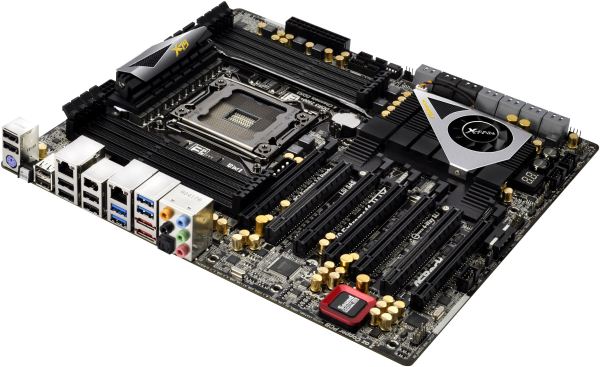ASRock X79 Extreme11 Review: PCIe 3.0 x16/x16/x16/x16 and LSI 8-Way SAS/SATA
by Ian Cutress on September 3, 2012 10:15 AM EST- Posted in
- Motherboards
- ASRock
- X79
- LSI
- PLX
ASRock X79 Extreme11
To conclude, it is hard to judge a motherboard like the ASRock X79 Extreme11. With no other major competing products offering similar functionality, ASRock can charge a pretty penny for the product. However, does it still retain the usefulness or bang for buck in terms of performance?
For your $600 of green, the main selling point is the X79 platform mixed with two PLX PEX 8747 chips which allow four PCIe devices to be run at x16/x16/x16/x16 in PCIe 3.0 or up to seven devices to be run at x16/x8/x8/x8/x8/x8/x8 also in PCIe 3.0. This combination leaves eight PCIe 3.0 lanes from the CPU, which are directed straight into an LSI SAS 2308 PCIe 3.0 RAID controller. This LSI chip gives eight ports capable of SAS2/SATA 6 Gbps speeds, in RAID 0, 1 or 10 configurations. An equivalent PCIe 3.0 card would set a user back several hundred as well as taking up a PCIe slot.
On top of the PLX and LSI chips, we also get a full-bodied X79 motherboard, featuring eight memory slots, dual Broadcom NIC capable of Teaming/Link Aggregation, a Creative Core3D sound chip, enhanced power delivery, and eight USB 3.0 ports via TI controllers. Software comes in the XFast flavors, with XFast RAM taking advantage of the ability of X79 to hold more memory. The board itself is also supports a multitude of Xeon processors, as well as ECC memory with the Xeons. There is a good amount in the box too, such as six SATA cables and a USB 3.0 panel, but it should be noted that this internal bundle is similar to cheaper ASRock products. The only thing missing in my opinion would be a WiFi connection on the IO, similar to that done by ECS.
Performance wise, the X79 Extreme11 does not win many accolades. It performs similarly or worse than other X79 motherboards in the market - in our GPU testing, the board continuously came near the bottom. The separation ASRock likes to make with the X79 Extreme11 is the PCIe functionality and the ability to include SAS drives on board - the speed of the extra ports reached a staggering 4.0 GBps, even though that may not be a realistic use scenario. The extra ports also are a little hampered by not having additional cache to help with writing short transfer sizes like on a PCIe card.
With our testing, and the price range of this motherboard, it is safe to say that this product is more aimed at workstation projects, such as an 8-core Xeon with ECC, rather than a product for gamers or overclockers. Tool it up with eight SAS drives, seven single slot GPUs, and away you go with a nice number crunching machine. Instead of paying in terms of price for performance, we are all talking about price for functionality here.
As a technical exercise, what ASRock have done is pretty amazing. In terms of pure innovation in a relatively stagnant market, I have to award the ASRock X79 Extreme11 a bronze award for pushing boundaries and enabling innovation in the motherboard market. This motherboard, paired with a deep wallet, could be a number crunching machine for video or audio enthusiasts, or GPU crunchers who yearn PCIe bandwidth but also SAS compatibility. This is strictly an enthusiast’s motherboard.

ASRock X79 Extreme11
AnandTech Editor’s Choice Bronze Award











62 Comments
View All Comments
StevoLincolnite - Monday, September 3, 2012 - link
Chipset fans.WHY!? They're noisy, probably fail quickly when filled up with dust...
I have the Asus Sabertooth x79 which has 2 small fans on it and the noise they generate drives me bonkers, thankfully the board has a 5 year warranty... Heck most of these chipset fans aren't even a standardized size so replacing them on your own is going to be tough/impossible.
Grebuloner - Monday, September 3, 2012 - link
I think you might want to check your board or your case cooling setup then. I can't hear the fans on my Sabertooth unless I stick my ear up to the grill on the I/O plate, and the chipset fan is inaudible over the 580 it sits next to.owan - Tuesday, September 4, 2012 - link
Its not rocket science, its right there in the review: 35+W underneath a very low-profile heatsink. Passive cooling just wasn't going to cut it. I swear, if people are going to complain about stuff on this motherboard, they could do a lot better than whinging about the fan.Master_shake_ - Tuesday, September 4, 2012 - link
i have an LSI 9260 add in card and that thing gets super hot, and the fan on this is really loud...just check out linus tech tips on youtube and you can hear it.
mike55 - Monday, September 3, 2012 - link
What are those little box-shaped components that are in the center of the CPU socket and appear in the dozens on every PCB I've ever seen?Ditiris - Monday, September 3, 2012 - link
They're capacitors for the CPU, more specifically decoupling capacitors.mike55 - Monday, September 3, 2012 - link
Ah, thanks! Good to finally know what the heck those things are.LamborghiniBooby43 - Monday, September 3, 2012 - link
As the X79 chipset does not have USB 3.0 as standard, ASRock have included Texas Instrument USB 3.0 controllers for a total of eight ports (4 on the back panel, 4 via two onboard headers) and a 2-port front USB panel included in the box. http://goo.gl/XbQv9JMC2000 - Monday, September 3, 2012 - link
If ASRock says this board is aimed at the workstation user, why in the world did they put those useless decorative metal shields on the heatsinks? Those things just scream out 'Gamer' to me.I would like to see someone build a dual-2011 socket board utilizing 4 of the PLX8747 chips.
Belard - Monday, September 3, 2012 - link
Yep... A Workstation board is just that... They don't need all the bling. Yes, this board has workstation features - but this looks nothing more than a board for an uber gamer who has money to spend.Of course, what game makes use of 4 gaming cards (yeah, the slots are only useful for rendering / compute type work).
Still, if you want to have EVERYTHING possible... this should be it.